



Suggested citation: Ghosh, Arunabha, Tulika Gupta, Shuva Raha, Hemant Mallya, Deepak Yadav, and Nandini Harihar. 2022. Rules for an Energy-Secure Global Green Hydrogen Economy. New Delhi: Council on Energy, Environment and Water.
This White Paper proposes eight principles of a rules-based architecture for decarbonised hydrogen. The paper is split into three sections - the first maps the existing global governance landscape for decarbonised hydrogen including existing networks and alliances; the second explains the eight principles; and the final section examines the potential design of such a cooperative framework and suggests their adoption by the G20.
Hydrogen is not just another fuel. Hydrogen is expected to serve as a primary industrial fuel in the 21st century, just as coal drove the 19th century and oil drove the 20th century. Decarbonised hydrogen – produced by splitting water into hydrogen and oxygen using renewable electricity (‘green’ hydrogen) or other low-carbon variants that sequester carbon emissions – could be a gamechanger in strengthening energy security and powering the energy transition.
However, there is no energy security architecture to protect the countries that will drive future energy demand or secure the necessary fuels. Countries are thus trying to unilaterally secure access to hydrogen value chains using their own energy security strategies. This race to secure hydrogen could intensify resource conflicts, exacerbate the already-intense global energy insecurity, and obstruct decarbonisation by restricting the access of most economies, especially the developing and Least Developed Countries (LDCs), to this crucial clean energy source.
A robust rules-based architecture is needed to secure the supply and demand of this critical fuel by governing technology development, production, trade and transport, storage, and use.
Decarbonised hydrogen, produced by reducing greenhouse gas (GHG) emissions, could help decarbonise heavy industries such as steel, ammonia and petrochemicals, as well as long-distance freight transport and energy storage, and become integral to novel applications such as sustainable aviation fuels (SAF).
The key drivers currently pushing demand for decarbonised hydrogen include significant advancements in the efficiency and reliability of hydrogen-producing electrolyser and fuel cell technologies, continued decline in the price of solar and wind energy, a projected increase in the efficiency of photovoltaic cells, and the need to achieve global netzero emissions by 2050.
The increasing importance of decarbonised hydrogen has led to many countries announcing specific strategies, policies and/or partnerships. As of August 2022, at least 38 countries (including 29 developed economies), and the European Union have announced developing national policies/strategies for hydrogen. Meanwhile, 39 bilateral partnerships for decarbonised hydrogen have been announced, focused on joint R&D, value chain creation and trade partnership, as of August 2022. Several multi-party alliances have also emerged, driven by business interests in specific regions rather than government-to-government discussions. This poses risk of regional fragmentation and unclear rules for technology development, supply chains and trade — unless governments collaboratively build a rules-based global architecture for decarbonised hydrogen.
In a decarbonised world, hydrogen must be accessible to all markets, affordable for retail and industrial consumers, available at scale to bridge the emissions gap, and acceptable as a reliable fuel source. The Council on Energy, Environment and Water (CEEW) proposes eight principles to develop a global, cooperative rules-based architecture based on resilience and equity that could harmonise the decarbonised hydrogen economy, by:
Cooperation and engagement on decarbonised hydrogen cover a broad range of issues involving many entities. The numerous bilateral and multi-party alliances indicate that countries have recognised the need for collaboration. Still, this collaboration could be stifled by bureaucratic charters, inflexible mandates or even unilateral policymaking. A clear framework for a rulesbased architecture based on these eight principles is essential to mitigate technology risks, circumvent supply disruptions, and ensure that the benefits of a new decarbonised industrial fuel are equitably accessible.
If hydrogen demand grows as projected, in line with bilateral and multi-party efforts, it is likely to displace coal and oil as a key fuel for heavy industries in this century.
Being the critical fuel of the coming century brings all-too-familiar challenges, with countries aggressively vying for control over the sources and value chains for their own energy security.
Unlike the hydrocarbons market, future energy systems reliant upon decarbonised hydrogen should not be vulnerable to price shocks based on market fluctuations, or geopolitical and climate risk factors (Cherp and Jewell 2014).
Figure 1: The colours of hydrogen
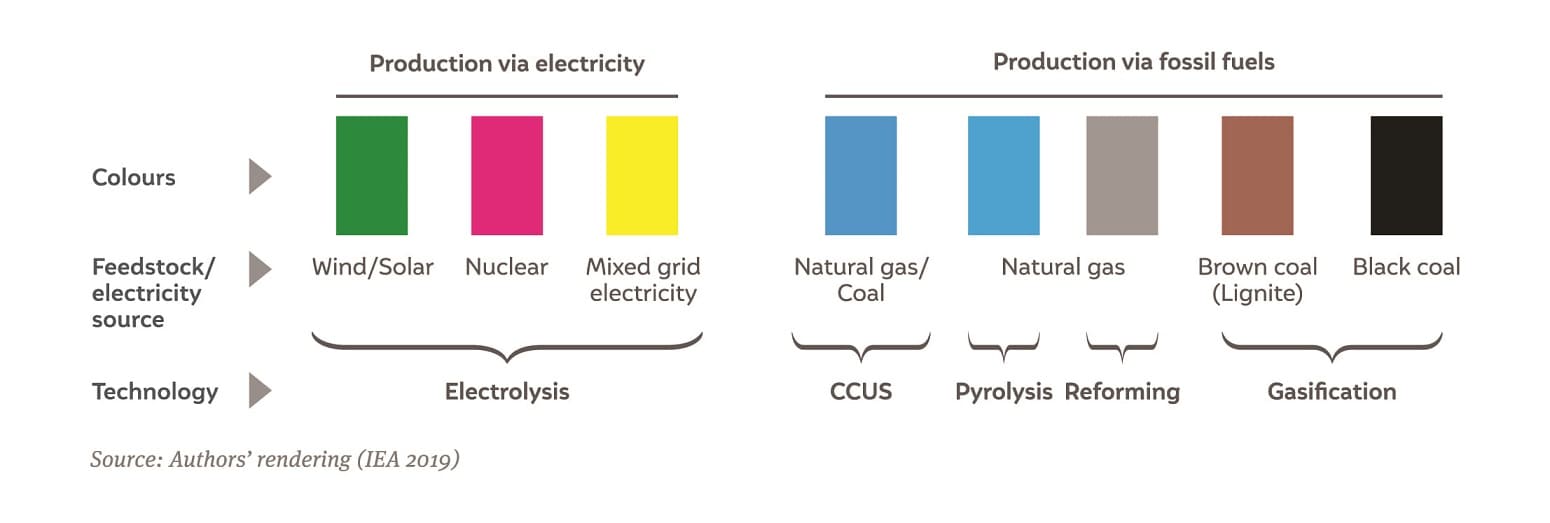
Of the hydrogen variants shown in Figure 1, green hydrogen is expected to dominate the market by 2050 (IRENA 2022). If well-governed, this low-carbon fuel could become a game-changer for strengthened energy security and reduced greenhouse gas (GHG) emissions, especially for sectors where direct use of electricity does not suffice as an energy source.
The challenge, though, is significant. In 2019, 34 per cent of global GHG emissions came from the power sector, 24 per cent from industry and 15 per cent from transportation (IPCC 2022). Decarbonising these sectors is essential for major economies to meet their net-zero targets and limit global temperature rise to 1.5°C by the end of the century (IPCC 2018).
Renewable energy, supplemented by battery storage, is helping to decarbonise the power and mobility sectors (including railways, which are conducive to electrification). But heavy industries such as steel, ammonia and petrochemicals, as well as long-distance freight, marine and aviation transport, need an alternative such as decarbonised hydrogen to be weaned off their deep dependence on cheaper and readily available fossil fuels.
Industries such as refineries and fertiliser plants already use a sizeable volume of hydrogen, adding up to 94 million tonnes (MT) in 2021 (IEA 2022). However, this prevalent variant is produced from fossil fuels, making it incompatible with net-zero pathways. Here, green hydrogen and decarbonised variants that use nuclear power or carbon capture and sequestration (CCS) to mitigate emissions could unlock the clean energy transition at a global scale.
The current high cost of decarbonised hydrogen is another major challenge. Grey hydrogen, produced from natural gas, costs between USD 0.5 and.7 per kilogramme (kg) (IEA 2022), while decarbonised hydrogen costs USD 3.5 - 4.5 per kg. For example, to achieve parity with grey hydrogen, many countries (and companies) have set ambitious ‘1-1-1’ targets for green hydrogen, i.e., USD 1 per 1 kilogram within 1 decade (by 2030). Achieving the 1-1-1 target needs changes in several vectors – halving the cost of renewable electricity, innovation in electrolyser technology for longer and more efficient lifecycles, investments in hydrogen giga-factories, and global economies of scale driven by demand-side pulls from end-use sectors.
Further, if the decarbonised hydrogen ecosystem develops in an ad hoc and exclusionary manner, resulting in market concentration, efforts at cost reduction would be curtailed, there would be competing standards for production and end-use sectors, and incoherent regulations that limit trade and investment.
These challenges present several sectoral or geographical dilemmas:
Decarbonised hydrogen offers an opportunity to pursue a new paradigm of technology co-development with complementary resources. The Global North has the first mover-advantage but cannot mitigate emissions unless decarbonised hydrogen is adopted globally, especially in geographies where investments in heavy industrial infrastructure are still rising. Several countries, mainly from the Global North, are rapidly building their national green hydrogen ecosystems and forming bilateral and multi-party alliances with allies and collaborators (IRENA 2022b). Meanwhile, many regions in the Global South have optimal conditions to produce renewable energy, and would be natural locations to produce decarbonised hydrogen. Also, many emerging and developing economies are undergoing industrialisation. This makes their buy-in for the hydrogen economy essential for decarbonisation. However, the Global South is held back due to the high cost of capital stemming from perceptions of high risk.
A more equitable approach to building the decarbonised hydrogen ecosystem offers many benefits. It could promote energy access, transparency and monitoring between advanced and developing economies, and inculcate best practices from the Global South to ease the adoption of disruptive technologies in these regions (Ghosh, Harihar and Jain 2022). Stakeholders worldwide, therefore, have an interest in collaborating to develop a rules-based architecture for decarbonised hydrogen to drive collective research, development and deployment of decarbonised hydrogen, thereby ensuring affordable, accessible, reliable and equitable supplies globally.
CEEW has identified the eight principles that could form the building blocks of a rules-based architecture for a decarbonised hydrogen economy based on an analysis of the global state of play, including country policies, bilateral and multi-party alliances, and a range of stakeholder consultations.
Decarbonisation efforts, cost-competitive renewables, technology advancements, and new policies signal that the current wave of interest in hydrogen will likely stay. Driven by oil price-shocks in the 1970s and the search for innovative solutions to the climate crisis in the 1990s and early 2000s, hydrogen has seen three distinct waves of interest over the past two decades. None could sustain against the low hydrocarbon prices (Ghosh and Chhabra 2021).
The fourth wave of interest is propelled by two major technological drivers: the vast advancements in the efficiency and reliability of hydrogen and fuel cell technologies, and the continued decline of solar and wind energy costs (IRENA 2020). The efforts in the fourth wave also have a strong global motivator: the imperative to simultaneously achieve energy security and net-zero emissions within the ambitious target years set by major economies (Ghosh and Chhabra 2021).
Several countries are propelling the market for decarbonised hydrogen by setting targets, policies and strategies. According to CEEW’s analysis, as of August 2022, 38 countries and the European Union (EU) have announced decarbonised hydrogen policies, with specific targets for hydrogen production and electrolyser capacity addition (Figures 2 and 3). Of these, 29 are developed economies. The EU plans to install 40 GW electrolyser capacity by 2030 to produce 10 million tonnes of green hydrogen per annum (MTPA) by 2030 (European Commission 2020). This will need investments of USD ~520 billion in renewables and USD ~46 billion in electrolysers (ibid).
In Asia, China has the highest electrolyser capacity addition target of 80 GW by 2060 (Yin 2022). Japan has started producing green hydrogen using solar energy in Fukushima, with a target of 0.42 MTPA by 2030 (Suda 2021). India announced its National Green Hydrogen Mission in 2021 and currently aims to add 5 MPTA of green hydrogen by 2030 (PIB 2022).
Australia intends to be one of the top three exporters of hydrogen to Asian markets (COAG Energy Council 2022).
Figure 2: Global green hydrogen production targets, in MTPA
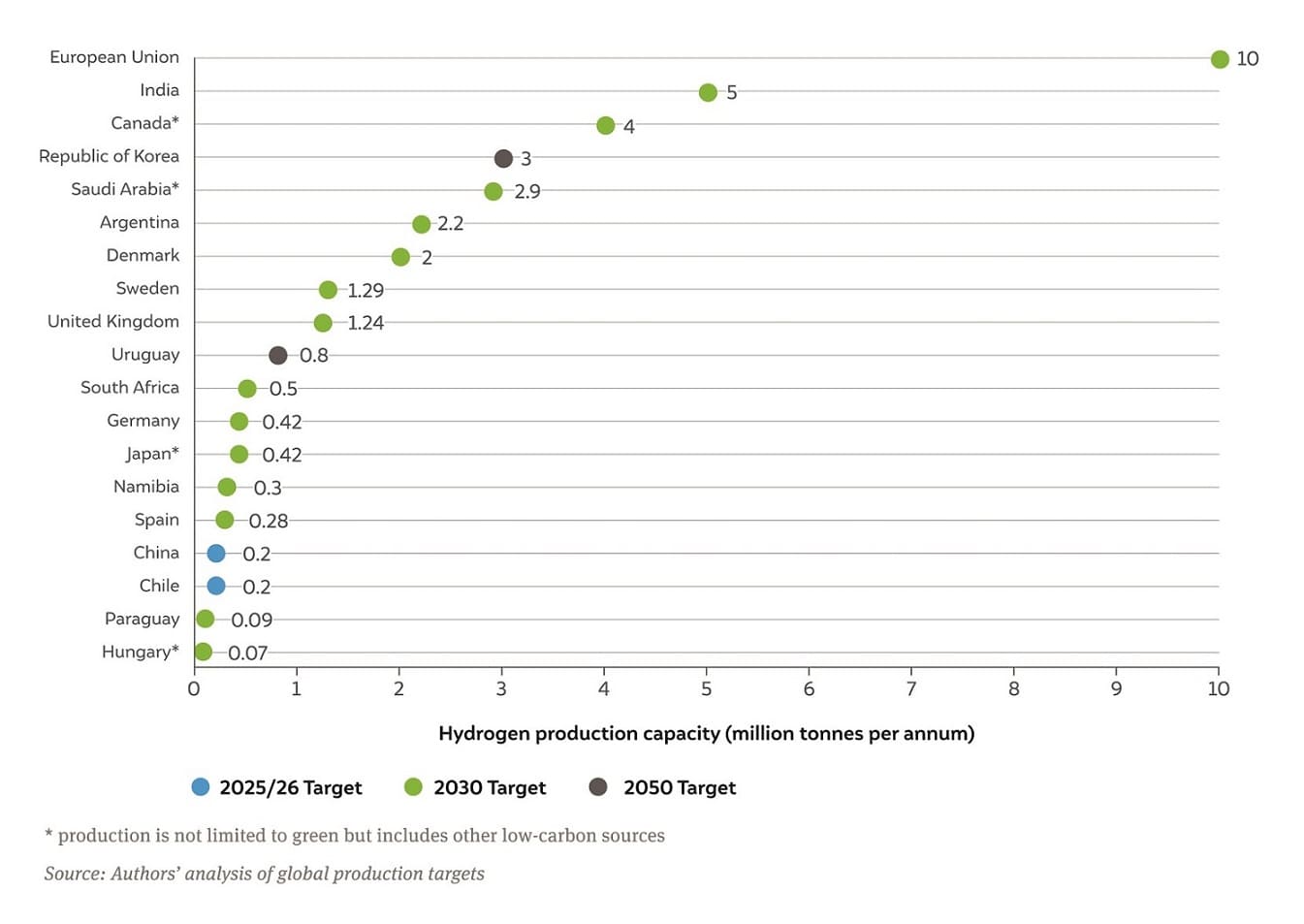
In the Middle East and North Africa (MENA) region, major oil producers are diversifying their energy mixes. Saudi Arabia is setting up the world’s largest green ammonia project, with 4 GW renewable energy capacity for electrolysis to produce 1.2 MTPA green ammonia (Ghosh and Chhabra 2021).
Figure 3: Projected global electrolyser capacity addition or imports by 2030
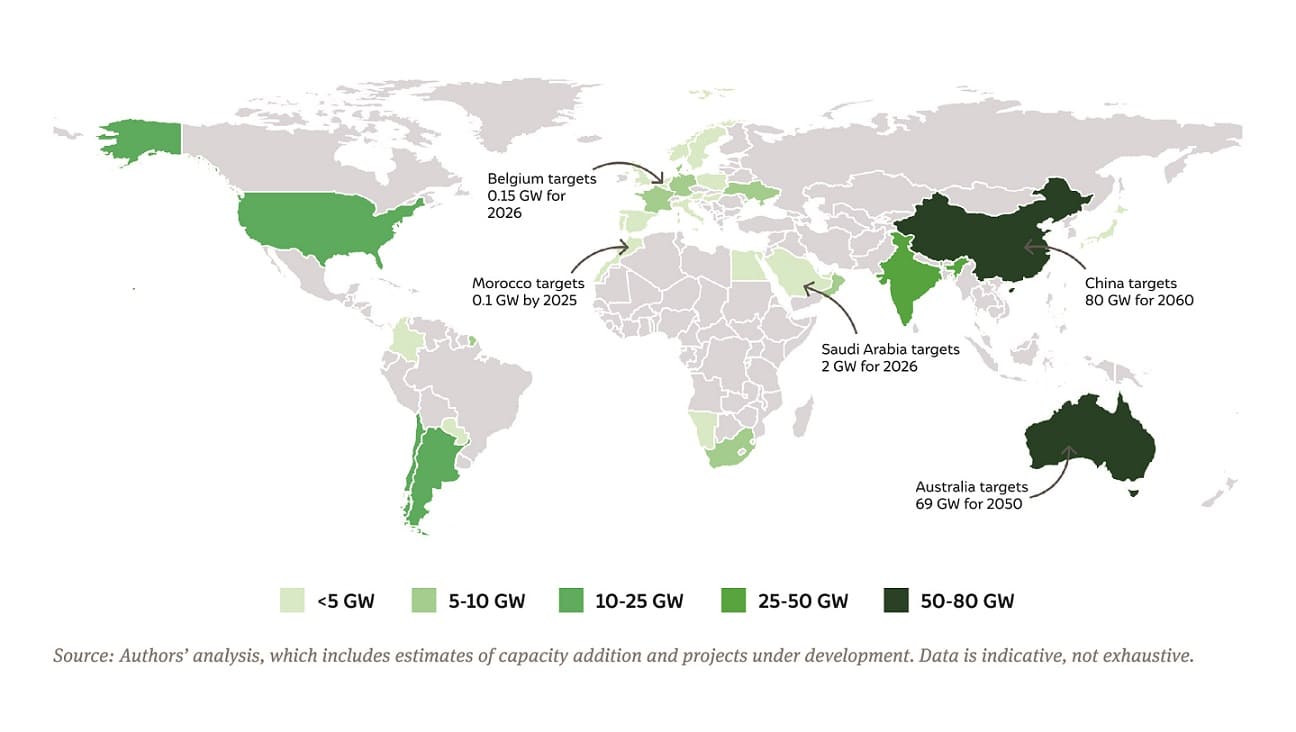
In 2020, Africa had only 54 GW renewable energy capacity, adding less than 2 per cent of total global capacity that year (Faria 2021) (IRENA 2021). Of the 604 projects in the low-carbon hydrogen project database of the International Energy Agency (IEA), only seven are being developed in the African continent, in Morocco, Egypt, Mauritania and South Africa (Moro 2022). Namibia and South Africa are the only African countries with specific green hydrogen targets.
Chile has taken the lead in Latin America with ambitious targets of 5 GW and 25 GW electrolyser capacity addition by 2025 and 2030, respectively. Colombia’s goal of 3 GW by 2030 mirrors those of developed economies such as Austria, Netherlands and Portugal (Irwin-Hunt 2022, Djunisic 2022).
Figure 4: Bilateral partnerships for decarbonised or green hydrogen: 38 and counting
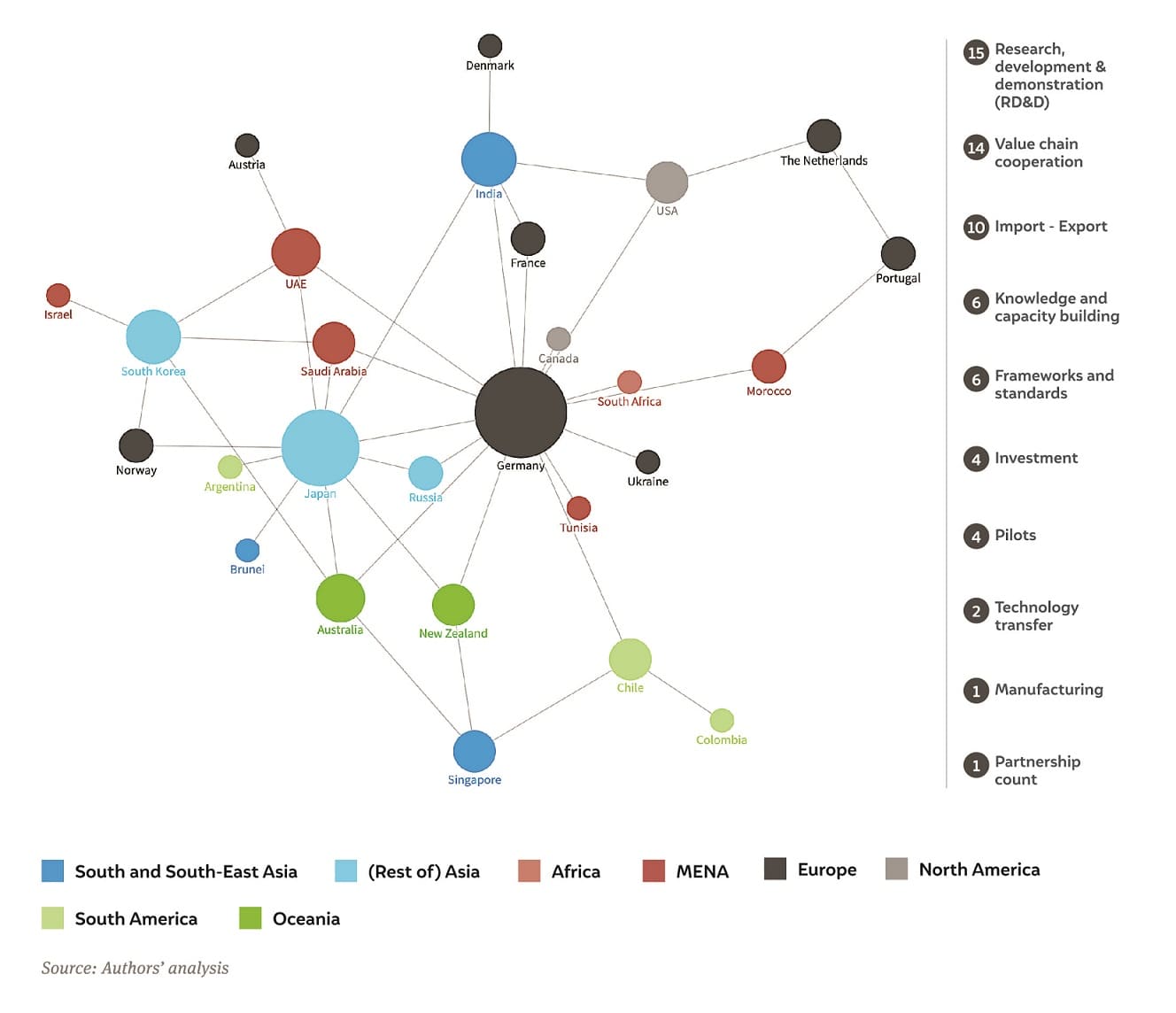
Bilateral partnerships signify the growing importance accorded to decarbonised hydrogen. At least 38 bilateral partnerships for decarbonised hydrogen had been announced globally as of August 2022. Figure 5 shows existing bilateral partnerships, with the size of each node reflecting the corresponding number of relationships. Germany makes up nearly a third of these, including partnerships with India, France, Japan, Morocco and the United States (US), followed by Japan.
Most of these partnerships are centred on joint research, development and deployment (RD&D).
Some address the entire value chain, while others are more transactional and focused on creating trade opportunities for long-distance import and export in high-demand centres. The only instance of South-South cooperation — a Chile-Colombia partnership — aims to consolidate production and carve out a Latin American market.
Some bilateral partnerships have fructified into supply contracts. For instance, the newly merged Port of Antwerp-Bruges inked a supply deal with the Ministry of Energy in Chile for green hydrogen (using green ammonia as a carrier) at EUR 1.10/kg by 2025 (Stones 2021). Under this contract, post-transportation delivery price expected to range around EUR 4.20/kg – cheaper than fossil-fuel-based-hydrogen.
Numerous multiparty alliances have also emerged worldwide and are working on various priorities of the decarbonised hydrogen value chain. While some have the involvement of countries, corporations are also in the lead in many networks, signifying the readiness of the market to invest in the infrastructure to adopt this new clean fuel at scale (Figure 5).
Notable examples of multiparty alliances include:
Most multiparty alliances are driven by business interests in specific regions. This ad hoc nature of multiparty alliances creates inherent risks of regional fragmentation and ambiguous and/or disharmonised rules for cross-regional technology development, supply chains and trade. Hence, governments must take the initiative to resolve these critical issues through consensus to build a robust global decarbonised hydrogen economy.
Figure 5: Multiparty alliances working on key priorities of the decarbonised hydrogen economy
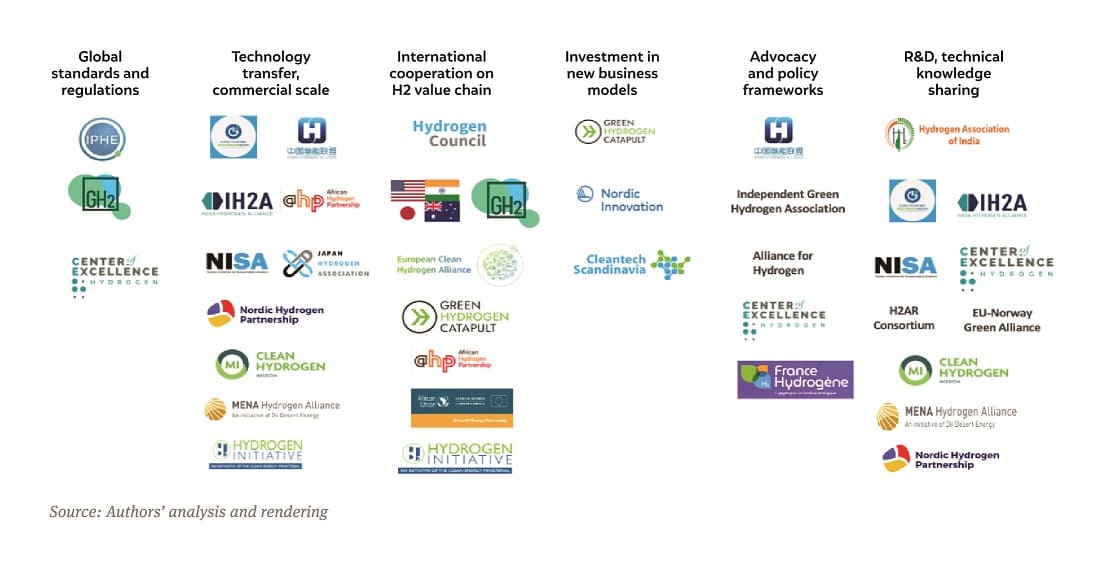
In 2021 and 2022, CEEW conducted several expert meetings and multistakeholder consultations on decarbonised hydrogen in India and Europe, including roundtables and technical workshops in New Delhi1 , Paris2 and Stockholm3 to supplement its analysis of the priorities and nuances of existing multiparty alliances. These consultations, comprising closed-door and public discussions, included policymakers and high-level experts from industry and research institutions.
The conversations revealed the shared concern that most countries are building their decarbonised hydrogen play competitively and not collaboratively. Combined with the analysis of country-level policies and partnerships, it is evident that an adverse situation is developing where:
First, although many countries in the tropics have substantial renewable and other low-carbon resources to produce hydrogen, the optimal geographical locations for decarbonised hydrogen production are not the preferred locations of projects and investments, in part due to the high cost of capital (Ghosh and Chhabra 2021, IRENA 2022),
Second, most hydrogen programmes and technologies are owned by entities in developed countries, and
Third, none of the multiparty alliances seeks to establish a rules-based architecture for decarbonised hydrogen.
Other challenges include a lack of viable commercial business models, a global (green) taxonomy, and harmonised standards and safety protocols between countries.
CEEW’s analysis and stakeholder meetings indicate the key areas for bilateral and multiparty collaboration to unlock and/or mobilise parts of the value chain for existing fuel replacements and new decarbonised hydrogen applications in transportation and machinery.
These include:
In a decarbonised world, hydrogen must be accessible to all markets, affordable for retail and industrial consumers, available at scale to bridge the emissions gap, and acceptable as a reliable fuel source.
CEEW’s analysis of country policies, bilateral and multiparty alliances indicates the need to develop a global, cooperative rules-based architecture based on resilience and equity to harmonise the decarbonised hydrogen economy.
First, a rules-based architecture must have legitimacy and be based on equity, wherein it equally enables all participants (The Royal Institute of International Affairs 2015). The fairness and effectiveness of any international system is often a matter of perspective. While the world has transformed since the Second World War, little has changed in the international order to reflect realignments in the global economy and trade flows. For the emerging decarbonised hydrogen economy to succeed, all interested countries must get a level playing field based on their energy needs, respective roles in developing the value chain, and the global decarbonisation imperative based on their common but differentiated responsibilities (CBDR).
Second, a rules-based architecture must recognise — and enable — the collective interest in developing the market for decarbonised hydrogen. Unlike hydrocarbon sources, which are concentrated in a few supplier countries, decarbonised fuels such as green hydrogen benefit from the much wider global availability of renewable energy and hydrogen’s relative ease of production.
All interested countries should be equipped with the mandate, tools and resources to develop and deploy decarbonised hydrogen at scale. Such collective market participation, especially from countries that have high renewable resources but lack the technological expertise and infrastructure to optimally utilise them, is crucial to achieve production scale and reduce emissions.
Third, diversity of energy sources and policy flexibility are essential to counter the vulnerability of imbalanced energy partnerships to geopolitical shocks. The decarbonised hydrogen economy must leverage a collaborative framework, supported by strategic reserve mandates, price negotiation forums and high-level dialogues, to address such vulnerabilities while ensuring energy access for the global population.
Fourth, the role of existing institutions must be considered for decarbonised hydrogen. For instance, agreements under the World Trade Organization (WTO) protect patents in decarbonised hydrogen but also restrain scope for subsidies to promote the technology. Annexure I illustrates how prominent global institutions’ mandates and activities intersect with hydrogen governance. Countries must venture beyond engaging individually with these institutions and have a dialogue to determine how such institutions should address the needs of the emerging hydrogen economy
CEEW has proposed eight principles to create a global, cooperative rules-based architecture for decarbonised hydrogen.
Seamless transboundary trade of decarbonised hydrogen and its derivatives is needed to reduce costs and guarantee supply. Hence, mutually accepted protocols for trade between countries based on interoperability of operational and safety factors to create systems for plug-and-play production, storage and end-use must be prioritised. Further, new and novel applications of decarbonised hydrogen such as ammonia combustion in thermal power plants or sustainable aviation fuels (SAF) need special monitoring to ensure operational quality and technical safety. Without a common baseline, each country will frame its own standards for the equipment and processes of the value chain. A technical supervisory committee could be established to set standards and protocols in collaboration with domestic regulatory authorities to ensure uniformity across jurisdictions and compliance by participating countries.
Free market principles are the primary drivers for mature fuels such as oil and gas (O&G) and liquefied natural gas (LNG). As hydrogen is expected to replace much of the hydrocarbons in a decarbonised world, a rules-based architecture is imperative to ensure that no country disrupts the global value chain. A global alliance on decarbonised hydrogen could build consensus around norms for an open market for decarbonised hydrogen and its derivatives to ensure healthy competition and lower prices, thereby enabling scale. Further, cooperatively developing rules could help minimise onerous offtake conditions for imports, such as technology and component purchase mandates, and allow long-term supply contracts to drive the market.
A lack of access to essential components could hinder efforts to scale up the decarbonised hydrogen ecosystem. Electrolyser production needs critical minerals like iridium, platinum, zirconium, lanthanum, nickel and yttrium, which have skewed global availability. For instance, China owns 60+ per cent of total rare earth element (REE) reserves; the Democratic Republic of Congo (DRC) owns 80+ per cent of cobalt, three countries (Australia, Indonesia and South Africa) own about half the world’s nickel, and four countries (Chile, Peru, China and DRC) hold more than half the global copper reserves. The processing capabilities of these critical minerals are also concentrated: China controls 90 per cent of the market to refine REEs, up to 70 per cent for cobalt and 35 per cent for nickel.
For proprietary components such as catalyst-coated membranes, open and transparent trade is also needed. These membranes do not yet have well-established supply chains, and price fluctuations could arise due to demand-supply discrepancies. Similarly, supply chain infrastructure for components like compressed / liquid hydrogen and liquid organic hydrogen carriers (LOHCs) in hydrogen shipping vessels is critical. A global alliance could cooperatively develop methods to address supply chain bottlenecks.
The many methods for classifying hydrogen, including the source of energy used to power the electrolyser (green for renewables, pink for nuclear, etc.) and the emissions intensity of each source, warrant a harmonised certification system managed by a global certifying body. This would help avoid ‘green premiums’ that countries importing hydrogen often have to pay depending on the emissions intensity of the imported fuel. The certification system could also address the impact of hydrogen production on water resources and monitor the efficiency of production technologies. A rules-based architecture could ensure representation related to all elements of the value chain from producer and consumer countries.
The long-term goal of sustainability unites the green innovation strategies of developed and developing countries. This needs technologies to be co-developed versus the current dominant paradigm of technology transfer (where technologies are developed and IP rights are formalised in developed countries, and subsequently sold or licensed to developing countries).
Technology co-development can create new and diverse value chains, bring down the cost of production, boost hydrogen use globally and lower emissions. Codeveloped projects (vis-à-vis direct investment) could be more symbiotic, involving partnerships between technology-rich countries, which lack the elemental resources; and resource-rich countries, which lack technological capacity to harness their resources.
Even where co-development is undertaken, there could be a lack of a uniform or reliable framework to determine which party retains the IP relegates the sharing rights to the negotiating prowess of the contracting parties. It is, therefore, necessary to establish explicit norms for co-developed projects, such as terms of co-financing, modalities for pooling technical and human resources, or rules for sharing IP for technologies that have been co-developed.
The price of decarbonised hydrogen and its derivatives depend largely on the cost of finance. This cost is significantly higher in most developing countries due to high perceived investment risk, lack of effective technology dissemination for scalable renewable electricity production, energy affordability, and the absence of political will. Also, the priorities of importing countries can fluctuate due to political factors, economic slowdowns and force majeure events, making it difficult for investors to rely on policy assurances. Investors are also wary of depending on long-term supply contracts with recovery horizons of several years, especially in the early stages of commercialisation. Such uncertainties impede the growth of the ecosystem.
A common funding pool, if designed to accommodate opt-in membership and project-specific participation, could provide investors and financiers with a network to finance projects, underwrite investments and provide guarantees, minimise contractual risk, and safeguard against arbitrary action. Collaboration between financial institutions could also help harmonise the criteria to obtain finance and insurance in this emerging sector. Further, such a funding pool could offer a platform to explore new ways to de-risk investment, such as green bonds and blended finance.
A pooled fund offers three key advantages:
Some efforts to pool funds are underway. In 2022, Gesellschaft für Internationale Zusammenarbeit (GiZ) and the European Investment Bank (EIB) signed an agreement to create a global green hydrogen trust fund, with an initial capitalisation of EUR 25 million provided by Germany (EIB 2022). The European Commission is creating a European Hydrogen Bank to invest EUR 3 billion to guarantee the purchase of hydrogen (European Commission 2022). Similar efforts are needed through North-South and South-South cooperation to de-risk finance for decarbonised hydrogen projects.
Collaborations across decarbonised hydrogen development and deployment programmes need common rules for licensing and IP sharing, including via open-source platforms. This would allow countries and institutions to retain their existing IPs while permitting new technology developed by groups and consortia-led programmes to be jointly owned, easing concerns of IP theft. Such a collaborative approach has already been adopted in other global technology partnerships like the Consultative Group on International Agricultural Research, the Human Genome Project, the CERN particle accelerator, and the International Thermonuclear Experimental Reactor.
Some countries are offering incentives for accelerated IP registration for ‘green’ technologies. These countries must agree on what is a ‘green’ technology and which parts of the decarbonised hydrogen value chain could be classified as green. For example, an electrolyser component does not by itself make hydrogen ‘green’, unless powered by renewable energy. This raises the question of whether it should be classified as a ‘green’ technology simply due to its application in producing green hydrogen.
Information asymmetry in the decarbonised hydrogen value chain could be reduced via technology collaboration and networking between industry, research laboratories and end-users via a transparent listing of projects and activities via a real-time, singlewindow portal with a searchable directory. This data could feed into the Paris Agreement’s Global Stocktake (the first of which is scheduled for 2023) to showcase the utility of decarbonised hydrogen technology in plugging the global emissions gap. A worldwide peerreviewed biennial technology status report would keep countries informed about persisting gaps and new collaboration opportunities. Progress in research areas across the value chain should be discussed and tracked to increase transparency. Such an approach would also help mitigate concerns about “greenwashing” by heavy polluters whose hydrogen projects overstate the extent of decarbonisation actually achieved.
The numerous bilateral and multiparty alliances for decarbonised hydrogen shows that countries have recognised the need for collaboration. However, such partnerships could be stifled by bureaucratic charters and inflexible mandates.
One advantage of decarbonised hydrogen is the diverse pool of producer countries with various sources such as solar, wind, tidal, hydro, geothermal and nuclear power. It would, therefore, be difficult for syndicates to drive this industry unlike hydrocarbons, and the core mandate of existing energy organisations would not apply. However, existing renewables-focused international organisations lack the firm mandate and the flexibility to support the emerging decarbonised hydrogen ecosystem.
On the financing front, multilateral development banks and development finance institutions can provide project finance. However, their scope, and mandates restrict their interventions to project-specific activities, rather than providing risk guarantees or other forms of blended finance at scale to crowd in more private investment.
Harmonising standards and certification systems for decarbonised hydrogen requires both – technical expertise and a negotiating platform. Bilateral contracts or multi-party alliances could mobilise some political, industrial and financial capital to help their members, but are typically business-oriented and operate in silos, creating inconsistent rules and competitive pathways. Most are constrained by their national and/ or regional membership structures and lack universal representation and scope for collaborative global policymaking. Existing alliances need to be shepherded towards a unified system to jointly built upon synergies that reduce the asymmetries between the various components of the value chain.
Annexure I shows that existing multilateral bodies have limited mandates for the breadth of rules that the emerging decarbonised hydrogen economy needs. In some cases, the rules and standards have to be designed or modified for decarbonised hydrogen. In other cases, the institutions are constrained by geographical focus.
In theory, any multilateral grouping can adopt the eight principles to propel — and improve — the global decarbonised hydrogen ecosystem. Function before form would be the preferred route, given the multitude of private actors, technical agencies, and multiparty networks that already populate the decarbonised hydrogen landscape. Table 1 illustrates the kind of institutional evolution that decarbonised hydrogen will need and the (limited) extent to which certain institutions/initiatives are working on these issues. Table 1 also highlights the existing gaps, necessary elements, and potential partners to deepen the functional outcomes.
But an overarching political mandate is missing. There is currently no energy security architecture to protect the countries that will drive energy demand in future or secure the energy fuels of the future. If the supply and demand of green hydrogen are not secured through global cooperation, countries will pursue their own energy security strategies without regard to others. This will lead to conflicts over access to minerals and technologies, market concentration and over-dependence on just a few countries, supply chain disruptions, and deprive many emerging markets secure access to a clean energy fuel to drive their industrial development.
The G20 brings together 85 per cent of the global economy and could serve as the ideal venue for the adoption of the eight principles. If the G20 adopted Principles of a Rules-based Architecture for Decarbonised Hydrogen, it could give guidance to operationalise the principles through other technical institutions. The principles would not be limited to the G20 membership and allow other countries to adopt and adhere to the rules-based governance of a strategic fuel.
Such an approach by the G20 would demonstrate farthinking statesmanship at a time of growing energy insecurity and avoid an energy crisis over hydrogen as it has repeatedly occurred over oil; catalyse and democratise access to clean energy technologies; and create conditions for greater private sector investment flowing into the Global South while promoting collaborations with the Global North.
Notes
1 CEEW’s September 2021 High-Level Seminar ‘A Multilateral Aproach to Building a Global Green Hydrogen Economy’ was organised with the Ministry of New and Renewable Energy, Government of India. It was chaired by the Union Cabinet Minister for Power and New and Renewable Energy, and featured the Ambassadors of Chile and Denmark, and senior representatives of the Embassy of Germany, British High Commission and the US Department of Energy
CEEW’s April 2022 Roundtable in New Delhi, India, ‘Green Hydrogen: Opportunities for India-UK Partnership’ was attended by industry chief executives from India and the United Kingdom, including members of a delegation of then-UK Prime Minister Mr Boris Johnson.
CEEW’s May 2022 Workshop in New Delhi, ‘Indo-French Partnership to Power a Decarbonised Hydrogen Industry’ was co-hosted with the Embassy of France and attended by over 100 key stakeholders.
2 CEEW’s April 2022 High-Level Roundtable in Paris, France, ‘Low-carbon hydrogen opportunities’ was co-organised with MEDEF International and France Hydrogène’s Hydrogen Task Force and the Conseil d’enterprises France-Inde.
3 CEEW’s April 2022 High-Level Roundtable in Stockholm, Sweden, ‘A Deal for Development: Global Governance of Green Hydrogen’ was coorganised with the Global Challenges Foundation, Sweden and attended by the Ambassador of India to Sweden and Latvia.
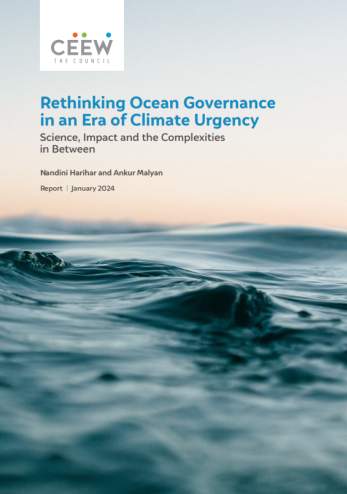
Rethinking Ocean Governance in an Era of Climate Urgency
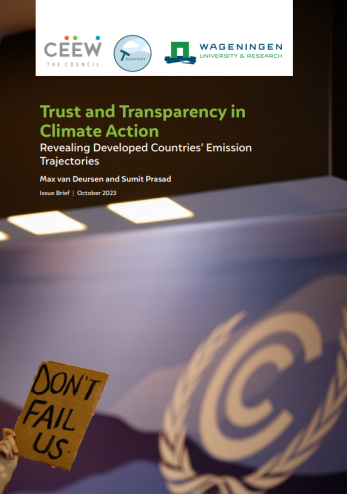
Trust and Transparency in Climate Action
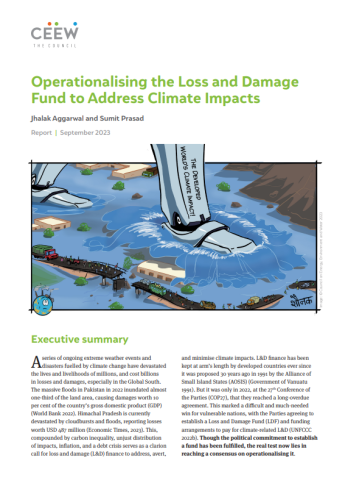
Operationalising the Loss and Damage Fund to Address Climate Impacts
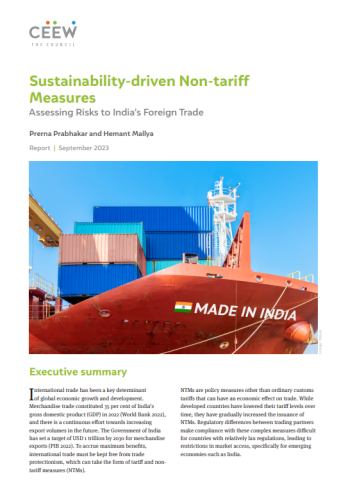
Sustainability-driven Non-tariff Measures